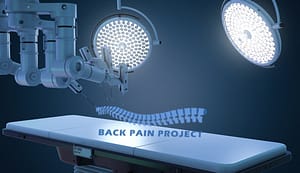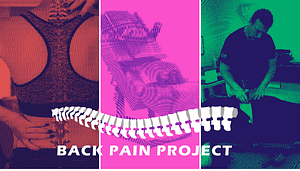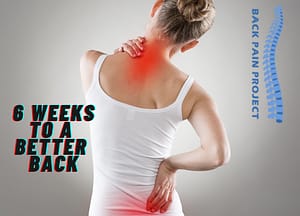Degenerative disc Disease and Low Back Pain
It is a lot simpler to call osteoarthritis arthritis and degenerative joint disease arthritis. So for explanation purposes here it will be called arthritis. So we all know that as we age we get arthritis, correct? There are three hallmark issues with arthritis that cause lower back pain. The first is obviously a pain. The next is a decrease in mobility, followed by wearing away the disc. Then since there is a loss of disc height the bone starts to wear away.
The Back Pain Project understands that arthritis pain, especially low back pain from arthritis is not reversible. What is important to know is that DJD can be helped by increasing mobility of the joint that is affected. The lack of mobility is by far the most serious concern. You either move it or you lose it. The Back Pain Project uses exercises combined with oxygen therapy to help keep the mobility you have and to increase it. Naturally, we are concerned with lower back pain due to arthritis.
Today we face many health crises, sitting way too much is one of them. Excessive sitting can really damage your lower back by weakening the muscles. Weak muscles allow the spinal bones to subluxate. As you know only chiropractors treat subluxations. Doesn’t make sense to try The Back Pain Project if you have back pain due to arthritis before its too late?
NSAIDs will mitigate some of the pain receptors affected by DJD, but will not stop the decay that occurs in the disc and the bones. The longer you take NSAIDs the more damage you do to your stomach. Long term use can also damage your liver and kidneys as well. So why would you keep taking NSAIDs?
Exercise for Osteoarthritis Back Pain
Exercise can be an effective means of managing degenerative disc disease (DDD) and related back pain. Appropriate exercise helps to strengthen the muscles that support the spine, improve flexibility, reduce stress on the discs, and increase mobility. It is important for individuals with DDD to consult a doctor prior to starting any physical activity program in order to ensure it does not aggravate their condition.
When considering exercises suitable for those with DDD, low-impact activities are generally preferable over high-impact ones. Low impact activities such as swimming, biking or using an elliptical machine will cause less strain on the discs than running or other high impact sports. Additionally, Pilates and yoga classes may help strengthen core muscles while increasing range of motion without putting too much pressure on weak vertebral joints.
It is also beneficial for individuals with DDD to incorporate stretching into their daily routine as this can aid in improving posture and decreasing discomfort caused by tightness in affected areas. While performing these stretches, care should be taken to avoid jerky movements which could potentially exacerbate symptoms associated with DDD. Moreover, adequate rest periods between bouts of exercise must be observed in order to allow time for recovery from strenuous activity; otherwise there is a risk of overworking already weakened spinal structures.
Definition Of Degenerative Disc Disease
Degenerative disc disease (DDD) is a condition that affects the intervertebral discs of the spine. It occurs when these discs deteriorate over time, leading to pain and discomfort in the back area. DDD commonly results from aging or wear-and-tear on the body due to activities such as sports or heavy lifting. The most common symptom associated with DDD is back pain which can range from mild to severe depending on its severity. Other symptoms include stiffness, numbness, tingling sensations, muscle weakness, and difficulty moving certain body parts. In some cases, DDD may lead to spinal stenosis or a herniated disc.
Diagnosing degenerative disc disease typically involves physical examination including X-rays or MRI scans to identify areas of damage or deterioration within an individual’s spine. Treatment options vary depending upon the severity of the condition but generally aim at reducing inflammation and alleviating any associated pain and other symptoms through medication, physical therapy exercises and lifestyle modifications such as avoiding activities that place stress on the lower back muscles. Surgery is sometimes recommended for more serious cases of DDD if conservative treatments fail to provide relief.
Causes Of Degenerative Disc Disease
Degenerative disc disease is a common cause of back pain, often occurring in the lumbar spine. The condition occurs when the discs between the vertebrae become weak and deteriorate, leading to nerve compression or other issues that can cause discomfort. Understanding potential causes of degenerative disc disease may help individuals recognize risk factors associated with developing this painful disorder.
The most frequent cause of degenerative disc disease is aging. As people age, their intervertebral discs naturally begin to wear down, making them more prone to injury due to increased susceptibility to mechanical stressors such as improper lifting techniques or prolonged sitting without proper support. Other physical activities such as sports or exercise can also contribute to the onset of degenerative disc disease by causing trauma directly to the spinal column. Additionally, genetic predispositions may play a role in an individual’s likelihood of developing this condition; for instance, some studies have shown that certain genes are linked to higher levels of cartilage degradation than others.
Finally, smoking has been identified as another factor that can increase someone’s chances of experiencing symptoms related to degenerative disc disease. This is because smoking reduces blood flow throughout the body, which in turn affects tissue regeneration and healing processes within the spine. Smoking also causes inflammation and restricts oxygen supply, both of which can lead to further damage in already weakened disks in the spine over time. It is important for those at risk for developing degenerative disc disease – particularly those who smoke –to be aware of these contributing factors so they can take steps towards preventing it from worsening or becoming chronic if possible.
Degenerative disc disease (DDD) is a condition that results from the deterioration of intervertebral discs in the spine. It commonly causes back pain and can lead to other health problems if left untreated. Understanding the symptoms of DDD may help individuals recognize when they should seek medical attention.
The most common symptom of degenerative disc disease is lower back pain, which is often described as achy or burning sensation. The intensity of this type of pain can vary depending on how severe the damage to the discs is; however, it generally does not increase with movement. In some cases, people may experience localized pain where their damaged disc is located, but it’s also possible for them to feel discomfort throughout their entire spine. Other potential symptoms include tightness or stiffness in the affected area, numbness or tingling sensations in nearby areas such as hands or feet, difficulty standing up straight after sitting for an extended period of time, and muscle spasms due to weakened muscles caused by reduced stability in spinal discs.
In addition to these physical symptoms, those living with DDD may also find themselves dealing with emotional distress resulting from chronic pain and decreased mobility. This could manifest itself through feelings of depression or anxiety because of being unable to do activities that were once enjoyed prior to developing DDD. If any of these signs are present, seeking medical attention from a qualified physician is advised so proper diagnosis and treatment can be administered promptly
Chiropractic Care is one of the most important non-surgical treatments for relieving back pain caused by degenerative disc disease. Physical therapists use various techniques such as stretching, strengthening exercises, massage, ultrasound, and electrical stimulation to reduce inflammation and improve range of motion. A physical therapist can also provide instruction on proper posture and body mechanics in order to minimize further damage from activities that involve lifting or bending.
Medication may be prescribed to help manage symptoms associated with degenerative disc disease including muscle spasms, inflammation, nerve irritation, and chronic pain. Commonly used medications may include over-the-counter anti-inflammatory drugs (NSAIDs), prescription muscle relaxants or narcotic analgesics if needed. Additionally, some doctors may recommend oral steroids for more severe cases of pain associated with DDD.
Lifestyle modifications are often suggested for people suffering from DDD in order to reduce stress on the spine and alleviate pain levels. Patients should avoid activities that involve heavy lifting or twisting motions as these can put additional strain on their lower backs. In addition to exercise programs specifically designed by a physical therapist to strengthen abdominal muscles which support the spine; other helpful strategies might include losing weight if necessary and seeking out ergonomic chairs at workstations so that good posture is maintained while sitting at desks all day long. Finally it’s recommended that individuals receive regular chiropractic care or acupuncture treatments as they may help relieve tension in the lower back area due to tight muscles surrounding the vertebrae affected by degenerative disc disease.
Surgery To Treat Degenerative Disc Disease
Surgery is an option for treating degenerative disc disease and its associated back pain. It can involve several types of procedures, including discectomy, spinal fusion, laminectomy, and artificial disc replacement (ADR).
Discectomy involves the removal of herniated or bulging disks that are pressing on nerves. It may be done in one or more areas depending on the severity of symptoms. This procedure aims to reduce pressure on nerve roots and alleviate nerve compression-related pain.
Spinal fusion surgery combines two or more vertebrae together with bone grafts from your own body. The goal is to create a single structure so the spine has better support and motion between bones is limited. Additionally, this type of surgery may help ease lower back pain caused by movement at affected parts of the spine.
Lastly, laminectomy is a decompression procedure which removes part of a vertebral arch called the lamina in order to widen the space around a compressed nerve root within it. ADR uses prosthetic discs made out of metal or plastic to replace diseased discs in order to relieve painful symptoms while allowing some degree of mobility in the neck or lower back region where they are implanted. Surgery options vary according to individual cases but all aim to improve quality of life through reducing pain levels and increasing range of motion.
While alternative therapies have been shown to be effective in managing degenerative disc disease, preventive measures can also play a vital role. These actions focus on improving posture and strength of specific muscles which support the spine and prevent further damage from progressing.
The first step of prevention is being aware of one’s own body mechanics and postural awareness. As such, individuals should strive for good ergonomics when sitting or performing any tasks that require repetitive movements over extended periods of time. Additionally, they should avoid activities that involve heavy lifting or twisting at the waist while carrying an object. This type of movement may cause additional stress on already weakened discs, leading to more severe pain.
Exercising regularly is another important factor in preventing further damage caused by degenerative disc disease. Doing exercises specifically designed to target core abdominal muscles as well as back extensors helps improve overall spinal stability and reduces pressure on existing structures within the vertebral column. It is recommended that those suffering from this condition consult with their doctor before beginning any physical activity program to ensure it is appropriate for them based upon their individual needs and capabilities. Call The Back Pain Project 203-656-3638 with any questions you have about osteoarthritis also called DDD.

FAQ's Degenerative Disc disease
Most frequent questions and answers
The duration of DDD varies significantly from person to person; however, it generally remains chronic unless treated with lifestyle changes or surgical interventions.
In addition to lifestyle changes non surgical spinal decompression is a powerful way to reduce pressure on the nerve by drawing the disc back into the proper location.
Regular exercise can help maintain strong muscles, ligaments, and bones in the spine while also improving flexibility, balance, and posture—all factors which play into the effectiveness of treatments related to degenerative disc disease.
One of the most popular remedies for DDD pain is exercise. Exercise helps strengthen muscles around the spine, promoting stability and reducing strain on discs in the vertebrae.
There is also a risk of infection and long-term scarring due to tissue trauma during surgery. Additionally, if spinal fusion is used in order to stabilize vertebrae, this could limit flexibility and range of motion in some cases.





